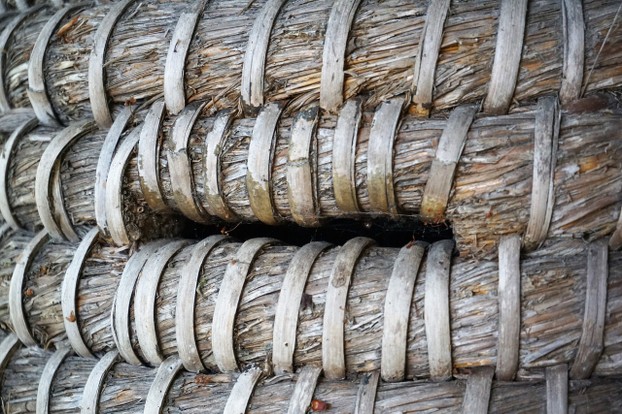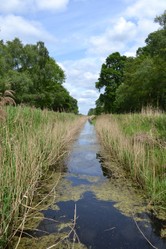If you travel through parts of England you may see a charming cottage roofed with thatch. These cottages are invariably expensive to buy and to maintain. They are always found in the countryside, and are a relic of an England long gone. But we British are a tradition-loving lot, and there are among us crafts people who still make use of rushes and similar plants for basketry and furniture. Thus they preserve ancestral traditions.
Image courtesy of Mazumbi, of Pixabay

Rushes
by frankbeswick
People have traditionally used rushes and other water plants for building and making utensils.
Rushes, Reeds and Sedges
A flat-bottomed boat is punted or paddled through the Norfolk Broads in the flat landscape of East Anglia, an expanse of water-filled peat diggings dating from Mediaeval times when East Anglians used to excavate peat and use it as fuel, as many people still do in Ireland and the Scottish Isles. A leisure boat passes, its bow wave causing the punt to rock a little, but the boatman heeds it not. He [and it is not always he, for there are women in this peaceable business too] stops the boat by an overgrown patch of fen [ boggy land ] on the bank, and begins to cut the vegetation by the bank. He loads the severed stems into the second punt that they are towing behind them, then skilfully turns the boats and returns to base, where the rushes are put through a drying process. The boat's crew are thatchers, plyers of an ancient trade that uses rushes, reeds and straw, etc, to make roofs. Some thatchers harvest their own materials, but most of the others buy it in from a variety of sources. Though few in number, these maintainers of a traditional craft provide a threefold service. They provide material for roofs and other items; they keep the fenland waterways clear for boating; and they maintain the ecology of the fen, preventing it from silting up.
Three fenland plants are used for thatching: rushes, reeds and sedges. But mainly rushes concern us here, as of the three they have the widest use. Reeds are tall, plants with feathery tops in their mature stage, while sedges are triangular-stemmed plants with a hard stem. They and reeds are only used for thatching in Europe, though in the Middle East and Egypt reeds were skilfully used to make boats. If you read the works of the Norwegian explorer Thor Heyerdahl you may read about the Ra expedition, in which he sailed an Egyptian papyrus reed ship across the Atlantic to investigate whether the ancient Egyptians could have reached America. There is no evidence that reed boats were used in the British Isles, but they are unlikely to last long once abandoned, so archaeologists are unlikely to find their remains.
The British Isles are a damp place, and historically, before improved drainage was introduced in the seventeenth century, there were large areas of wetland. Certain areas were wetter than others, and the rule tends to be that Britain gets wetter the further north and west you go. Ireland, with its distinct saucer shape created by its rim of high ground which focuses water in its low-lying flat centre, is wet. It is significant that traditions that celebrate rush usage are commoner in the north of England than they are in the drier south. We can see why rush-strewing traditions are preserved in Cumbria, in North-West England, for it is one of England's wettest areas, as the stormy weather of recent years has emphasised. Rushes are part of the landscape in that scenic area, and they are easy to find.
Basketwork
 Basketwork in a skep The Gadman, courtesy of Pixabay |
The Uses of Rushes.
Rushes have a peaceful history, they have never, as far as I know, been implicated in war, and there has been little or no change in use for a long time, save that we now use them less than we did.
Strewing was a major use. Depending on how wealthy they were people strewed their floors with rushes at least once a year. Wealthier people did it more than once. This was in the days before fitted carpets. Rushes provided a soft, warm flooring in houses with stone floors and in churches. In stone-floored houses anyone who walked barefoot would have appreciated rush flooring as it prevented their getting cold feet. The rushes were when possible mixed with herbs, some of which provided pleasant scents, such as rosemary, and others of which were insecticidal, such as garlic, pennyroyal and wormwood. Rushes could be woven into mats, though these would generally have been small, as rushes are small plants. The Japanese still make tatami mats from rushes, which are 176 centimetres long.
When the floor was cleared of dry rushes they would have been used as kindling for the fire. Nothing was wasted.
Another use is rush candles, which were made by repeatedly dipping dried rushes into tallow. If the candle was kept thin it was simply a rush candle, but if it was allowed to thicken out the rush served as a wick. As rushes have hollow stems they easily fill with melted wax, and this helps them to burn. They could also serve as the wick of an oil lamp. Fed through a hole into a container of oil they would take up the oil through capillary action in their their hollow stems and burn well.
But an important use was basketry. Rushes were woven and twisted into strong strands or ropes and then several strands would have been woven into a mat, which was then fastened to the wooden framework of a chair to form the seat. How long these rush seats lasted is unclear. But baskets were also made out of rushes by basket makers, using the same technique.
One form of basketry now rendered obsolete by modern developments, is the skep. This was a basketwork beehive, used by beekeepers up to the nineteenth century before modern hives were designed. Mediaeval monks used to place skeps in alcoves in the walls of walled gardens to protect them from wind and other causes of damage, a necessary move as they were quite lightweight compared with modern hives. You can see an example of the basketwork in a modern skep in the large image in this article.
There are limited uses of rushes in herbal medicine, though there were some old remedies for their use for sore throats, but modern herbal medicine has largely by-passed them. Apparently, the roots of the common rush are considered edible, but they are not commonly eaten and some people disagree about their edibility. Play safe and don't eat. Rushes are considered toxic for sheep and cattle.
Rushes played a significant part in the lives of our forebears and as plastics fade out they may still have a future. They are a small, but interesting part of social and economic history.
I am an Amazon associate and I earn money from qualifying purchases on this page.
You might also like
A Strong Woman's StoryJane Evans went to War, but fought no one, for her mission was mercy and kind...
Sarn Helen. Through Wales on footSarn Helen is a Roman route which travels Wales from South to North, and the...
Surprise at StonehengeArchaeologists have puzzled about the origins of the stones at Stonehenge. Bu...






 Pilgrimage. A review15 days ago
Pilgrimage. A review15 days ago
 Leo the Fourteenthon 05/09/2025
Leo the Fourteenthon 05/09/2025
 The Melsonby Hoardon 03/25/2025
The Melsonby Hoardon 03/25/2025




Comments
Most certainly we would like it, but we have less space than you have in the USA, so the wild flower gardens that you describe would be smaller than yours is.
This past summer I've been respecting the non-turf grasses and wildflowers that grow along and in the driveway and along the north and south lawns and the east and west yards. I keep the grass trimmed enough to give support to the flowers but not enough to flop over or hide the wildflowers. In some places, where there are seedlings, I hand-mow the soil so that the vegetation is forest floor-like in its sparseness. I leave dandelions where they are, before, during and after flowering. I particularly like the landscape architecture of their straight- and sturdy-stalked puffballs.
My sister and some other western pond-siders like what I do. They especially like the blue-flowering plants such as borage and chicory and the shade garden of blue- and white-flowering violets.
Might eastern pond-siders like what in essence may be called a weed garden?
Writer Artist
a very good point. I agree.
You are quite right on this matter.
I cannot help but compare rushes with bamboo. Bamboo is extensively used to weave basket, paper industry and more. Jute is used for making bags, artistry, crafts. Hope all these plants help reduce plastic which looks indispensable.
I think that the worst weather might force its way through,but well made thatch roofs withstand some bad storms.no specific herb stands out as especially protective.
Your introductory paragraph describes thatched-roof cottages as "invariably expensive to buy and to maintain." The subheading The Uses of Rushes indicates that rushes mixed with herbs such as rosemary "provided pleasant scents" and those mixed with such herbs as garlic, pennyroyal and wormwood "were insecticidal."
Would not thatched roofs be particularly susceptible to such inclement weather as heavy precipitation and high winds? Would there have been some herb or some procedure that would encourage better and longer wear and tear?
They relied on natural growth. There were no farms dedicated to the purpose of growing reeds rushes or sedges, though some estates had their own sources of these plants.
Did reed, rush, sedge basketry, candle-making, floor-strewing and herbal medicine deplete reeds, rushes and sedges growing naturally or did they require natural reeds, rushes and sedges and reed, rush and sedge farms?
Would their return rely upon natural growth or would it require natural growth and reed, rush and sedge farms?
Whyyyyy? Oh why? ...would MY memory go back as far as yours ? :) when you are so much older than I!
I do remember the basket